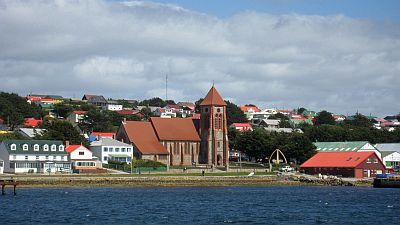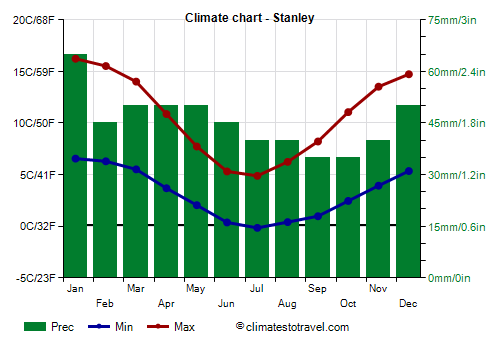Select units of measurement for the temperature and rainfall tables (metric or imperial).
Average weather, temperature, rainfall, sunshine
The climate of the Falkland Islands (or Malvinas) is
cold maritime: winter is cold, windy and snowy, while summer is very cool, if not cold, and it's rainy and windy as well. Relative humidity is high, and the sky is often cloudy throughout the year. In autumn and winter, the
wind can be stormy.
The average temperature of the warmest months is just over 10 °C (50 °F), this means that the climate of these islands is
almost subpolar, and it's similar to that of Iceland, although it's slightly milder.
The islands are located in the South Atlantic Ocean, so they have reversed seasons in comparison with the Northern Hemisphere.
Precipitation is not abundant, around 550 millimeters (21.5 inches) per year, since a part of it falls on Chile, on the western Andean slopes, which are not far. However, the rains are frequent and well distributed throughout the year.

In fact, the
westerlies blow all year round, so, weather fronts pass over the islands one after another, bringing clouds and rain (or snow), interspersed with sunny intervals, usually short-lived, or with variable or unstable weather.
Both the influence of the sea and the constant winds reduce the
temperature range, so the islands rarely experience either warm weather or intense frosts. Generally, the temperature drops to -4/-5 °C (23/25 °F) on the coldest nights of the year, while it reaches 22/23 °C (72/73 °F) on the warmest days.
However, in the
colder period, from April to October, snowfalls are frequent; moreover, wind and humidity exacerbate the feeling of cold. Some cold nights, with temperatures around freezing (0 °C or 32 °F), are possible even in summer, and in inland hills, snowfalls can occur even in this season.
The climate in detail
Temperature and rain
Stanley

In the capital,
Stanley (formerly Port Stanley), the average daily
temperature of the warmest months, January and February, is about 11 °C (52 °F), with highs around 16 °C (61 °F), while the average of the coldest months, namely June, July and August, is about 2.5/3 °C (36.5/37.5 °F), with highs around 5/6 °C (41/43 °F).
In 1992, the temperature reached 29 °C (84.5 °F) in January and dropped to -9.5 °C (-9.5 °F) in July.
Precipitation amounts to 545 mm (21.5 in) per year.
On the Falkland Islands, the
sun is rarely seen in winter, when the sky is often cloudy, while in late spring and summer, all in all, it shines for a decent number of hours. On average, there are 1,650 hours of sunshine per year.
The
sea is cold all year round, in fact the water temperature ranges from 5 °C (41 °F) from July to September, to 9 °C (48 °F) in January and February.
When to go
The best time to visit the Falklands is the austral summer, from
December to February, since it is the mildest period of the year. However, even in this period, there are wind and rain, and it can sometimes be a bit cold. Therefore, it will be useful to bring warm clothes.
What to pack
In winter (June to August): bring warm clothes, such as a down jacket, a hat, gloves, a wind jacket, and a raincoat or umbrella.
In summer (December to February): bring a sweater, a shirt, a jacket, and a raincoat or umbrella.
Climate data - Falkland Islands
| Stanley |
|---|
|
| Jan | Feb | Mar | Apr | May | Jun | Jul | Aug | Sep | Oct | Nov | Dec |
|---|
| Min temp. | 7 | 6 | 6 | 4 | 2 | 0 | 0 | 0 | 1 | 2 | 4 | 5 |
|---|
| Max temp. | 16 | 16 | 14 | 11 | 8 | 5 | 5 | 6 | 8 | 11 | 14 | 15 |
|---|
| Precip. | 65 | 45 | 50 | 50 | 50 | 45 | 40 | 40 | 35 | 35 | 40 | 50 |
|---|
| Prec. days | 17 | 12 | 15 | 14 | 15 | 13 | 13 | 13 | 12 | 11 | 12 | 15 |
|---|
| Humidity | 70% | 73% | 76% | 81% | 85% | 87% | 86% | 83% | 79% | 72% | 69% | 69% |
|---|
| Day length | 16 | 14 | 12 | 10 | 9 | 8 | 8 | 10 | 12 | 14 | 16 | 17 |
|---|
| Sun hours | 6 | 6 | 5 | 4 | 2 | 2 | 2 | 3 | 4 | 6 | 7 | 6 |
|---|
| Sea temp | 9 | 9 | 9 | 8 | 7 | 6 | 5 | 5 | 5 | 6 | 7 | 8 |
|---|